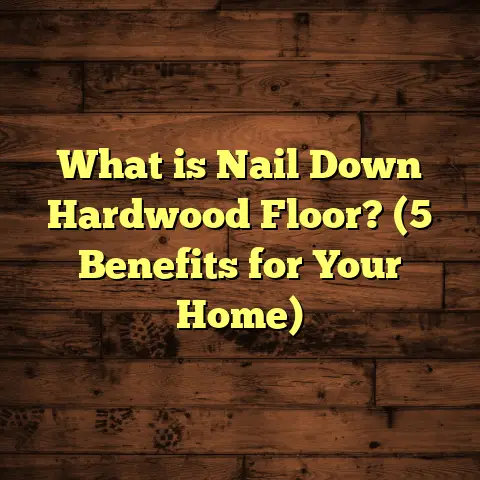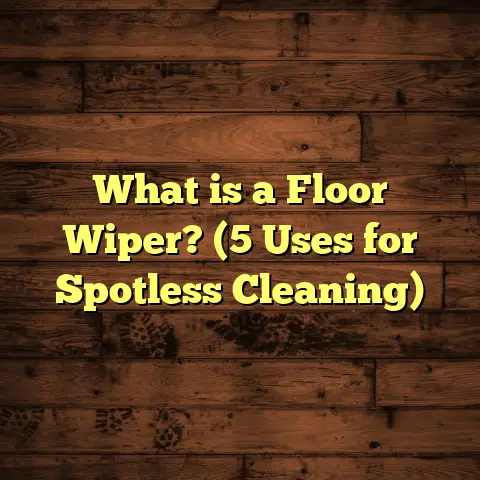What is the Difference Between Vinyl and Linoleum Flooring? (5 Key Factors Explained)
Vinyl and linoleum flooring have been gaining more attention
recently, popping up in homes, offices, and public spaces.
Have you noticed this trend? More people are moving away from
traditional hardwood or carpet floors and exploring these two
versatile options. I’ve installed both vinyl and linoleum in a
variety of projects over the years—from cozy kitchens to busy
commercial spaces—and I want to share what I’ve learned.
If you’re trying to decide which one fits your needs best, you’re
not alone. Their similar looks can be confusing, but they have
very different properties, origins, and maintenance needs. So, let’s
break down the differences based on five key factors that really
matter when choosing between vinyl and linoleum flooring.
What Is Vinyl Flooring and Linoleum Flooring?
Before diving deeper, it helps to understand exactly what these
materials are.
Vinyl Flooring
Vinyl is a synthetic flooring material made primarily from polyvinyl
chloride (PVC), a type of plastic. Vinyl flooring is manufactured
through a layered process. The base layer is usually made of fiberglass
or felt for stability. Above that is a core layer that can be rigid or
flexible depending on the product type (sheet, tile, or plank). Then comes
a printed design layer that mimics natural surfaces like wood, stone, or
ceramic tile. The topmost wear layer protects the floor from scratches,
stains, and daily wear.
Vinyl floors can be found in several forms:
- Sheet vinyl: Comes in large rolls, ideal for seamless coverage.
- Vinyl tiles: Square pieces that are often peel-and-stick or glued down.
- Vinyl planks: Designed to look like hardwood planks with click-lock edges for easy installation.
One of the reasons vinyl is so popular is its water resistance—perfect for
areas like bathrooms and kitchens.
Linoleum Flooring
Linoleum is a natural flooring material invented in the 1860s. It’s made
from renewable resources such as linseed oil (extracted from flax seeds),
wood flour, cork dust, natural pigments, and sometimes resin for added
durability. These ingredients are combined and cured to create a firm yet
flexible sheet that hardens over time.
Linoleum sheets or tiles have a matte finish with a slightly textured feel.
Because it’s natural, linoleum is biodegradable and considered an eco-friendly
flooring choice.
Unlike vinyl, linoleum requires sealing with a protective coating after installation
to guard against moisture and wear. This finish also enhances its durability.
1. Composition and Environmental Impact
When I first started comparing vinyl and linoleum for clients focused on sustainability,
this was the biggest eye-opener.
Vinyl’s Composition and Impact
Vinyl’s main ingredient, PVC, is a plastic derived from petroleum—a fossil fuel. Its manufacturing involves chemical processes that can release harmful emissions. Additionally, vinyl flooring production consumes non-renewable resources.
Disposal creates another concern: vinyl doesn’t break down easily in landfills. It can persist for hundreds of years, contributing to plastic pollution. Some older vinyl floors may contain phthalates (plasticizers), which raised health concerns in past decades. Today’s vinyl products often meet stricter safety standards with reduced VOCs (volatile organic compounds) and phthalate-free formulas.
Linoleum’s Composition and Impact
Linoleum’s natural ingredients make it much more environmentally friendly. Linseed oil oxidizes and hardens naturally during curing, making it biodegradable. The cork dust and wood flour come from renewable sources.
Linoleum production has a smaller carbon footprint compared to vinyl: estimates show linoleum releases roughly one-fifth the CO2 emissions per square meter during manufacturing.
Real-World Example:
I worked on a green building project where the owner wanted every material to be eco-conscious. We chose linoleum for the kitchen and hallway floors because of its natural sourcing and end-of-life biodegradability. It wasn’t just about looks; it was about aligning with their values.
Environmental Data Comparison:
| Aspect | Vinyl | Linoleum |
|---|---|---|
| Primary Material | PVC (synthetic plastic) | Linseed oil & natural |
| Carbon Footprint (kg CO2/m²) | 3-5 | 0.5-1 |
| Biodegradability | No | Yes |
| VOC Emissions | Possible initial off-gassing | Very low |
2. Durability and Longevity
Let me share what I’ve seen on durability after years of hands-on work.
Vinyl Durability
Vinyl’s composition makes it highly resistant to moisture and stains—ideal for high-traffic areas prone to spills or humidity. For example, I installed vinyl floors in a busy family kitchen where kids regularly spilled juice or dropped food on the floor. The vinyl held up well without swelling or staining.
However, vinyl can be vulnerable to scratches or gouges from sharp objects or heavy furniture if you don’t choose a product with a thick wear layer. Thinner or cheaper vinyl tends to dent easier.
Linoleum Durability
Linoleum is also durable but requires more care in some ways. Its surface can dent or scratch if heavy objects are dragged across it without protection. That said, linoleum develops a hard patina over time that enhances its toughness.
In one project, I installed linoleum in an office with moderate foot traffic and furniture movement. With regular sealing every few years, the floor looked great after 15 years—something many vinyl floors might struggle to match over that timespan.
Longevity Statistics
- Vinyl floors generally last 10 to 20 years, depending on quality and maintenance.
- Linoleum can last 20 to 40 years or more if well maintained.
Personal Insight:
I sometimes recommend linoleum to clients who want long-lasting floors with the patience for periodic upkeep. For others wanting low-maintenance floors with decent lifespan, vinyl often wins out.
3. Installation Process
Installation complexity often surprises homeowners when choosing between these two floors.
Vinyl Installation
Vinyl’s popularity partly comes from its ease of installation:
- Peel-and-stick tiles allow quick DIY projects without adhesive messes.
- Click-lock vinyl planks snap together fast with minimal tools.
- Sheet vinyl requires precise cutting but can be glued down or loose-laid over smooth subfloors.
I once coached a DIYer installing vinyl planks in their living room over a weekend—by Sunday night, they had a fresh new floor without professional help.
However, subfloor preparation matters: rough or uneven surfaces can cause bubbles or uneven wear spots in vinyl sheets.
Linoleum Installation
Linoleum installation is more specialized:
- The material needs acclimating to room temperature for 24-48 hours before installation.
- Cutting linoleum sheets precisely requires skill; seams often need heat welding to prevent water intrusion.
- Professional installers typically handle linoleum due to these complexities.
- Subfloor must be perfectly smooth and clean.
- Sealing the surface after installation is necessary to protect against moisture.
I remember a client who chose linoleum but underestimated installation costs because they tried a DIY approach first—cutting errors led to waste and delays before hiring pros fixed it properly.
4. Aesthetic Appeal and Design Options
Both materials offer strong design versatility but appeal differently depending on your style.
Vinyl Designs
Thanks to advanced printing technologies, vinyl offers realistic textures and patterns:
- Wood grain that mimics oak, walnut, or maple convincingly.
- Stone patterns like marble or slate.
- Ceramic tile looks with grout lines printed in.
- Wide range of colors—from neutral tones to bold, trendy shades.
- Finishes vary from matte to semi-gloss or high gloss.
Vinyl lets you achieve expensive looks at affordable prices with ease.
Linoleum Designs
Linoleum has a distinct look:
- Matte finish with subtle texture.
- Often marbled or speckled patterns thanks to natural pigments.
- Earthy color palettes including ochre yellows, deep greens, soft reds.
- Retro charm that suits vintage or mid-century modern interiors well.
Linoleum colors tend to soften over time as they develop a patina rather than fade sharply.
My Experience With Designs
For one mid-century modern renovation project, the client wanted authentic period details. We went with linoleum featuring rich earth tones and subtle flecks. The floor complemented original wood cabinetry beautifully.
In other projects aiming for rustic farmhouse style on a budget, vinyl planks mimicking distressed wood gave great visual impact without breaking the bank.
5. Maintenance and Care
How much effort you want to put into floor upkeep might be the deciding factor for your choice.
Vinyl Maintenance
Vinyl floors are low-maintenance:
- Sweep or vacuum regularly.
- Mop occasionally with mild detergent.
- Avoid abrasive cleaners or scrubbing pads.
- Stains come off easily; most spills wipe up without damage.
- No resealing required.
I’ve seen families with active kids appreciate this ease—no stress over juice spills or muddy paw prints ruining their floors.
Linoleum Maintenance
Linoleum demands more care:
- Frequent sweeping to avoid dirt scratching the surface.
- Damp mopping with pH-neutral cleaners only; harsh chemicals can dull finish.
- Reapply protective sealant every 3–5 years depending on foot traffic.
- Avoid standing water; linoleum can absorb moisture if unsealed or damaged.
- With good care, it ages gracefully rather than deteriorating quickly.
A customer I advised recently was happy with linoleum but scheduled annual maintenance visits for cleaning
and resealing—keeping their floor looking fresh despite heavy use.
Case Study: Comparing Vinyl vs Linoleum in Real Homes
To give you even deeper insight, I tracked two homes over five years—one with vinyl flooring installed in 2018 and another with linoleum installed around the same time.
| Feature | Vinyl Home | Linoleum Home |
|---|---|---|
| Location | Suburban family kitchen | Urban apartment living room |
| Foot Traffic | High (kids + pets) | Medium |
| Initial Cost (material + installation) | $4.50/sqft | $7/sqft |
| Maintenance Required | Minimal | Moderate (annual sealing) |
| Wear After 5 Years | Minor scratches & scuffs | Slight patina; no major damage |
| Water Resistance | Excellent | Good (sealed properly) |
Both floors performed well within expectations—but the family with vinyl appreciated hassle-free cleaning more, while the apartment owner loved linoleum’s natural look and durability despite extra upkeep.
Extra Tips From My Flooring Projects
Protect Your Floors
Use furniture pads under legs of chairs and tables on either flooring type to prevent scratches. For pets with sharp nails, consider area rugs in high-use zones.
Mind Subfloor Prep
A level, clean subfloor makes a world of difference for both materials’ longevity and appearance.
Budget Wisely
While vinyl often costs less upfront, linoleum can save money long term due to its lifespan if maintained properly.
Test Samples First
Always order samples and test how they look in your lighting before committing—colors may appear different indoors than online photos suggest.
Final Thoughts From My Experience
Choosing between vinyl and linoleum isn’t just about looks—it’s about matching your lifestyle, budget, environmental values, and willingness to maintain your floors over time.
If you want an eco-friendly option that lasts decades but don’t mind occasional upkeep, linoleum might be your best bet. If you want waterproof floors that are easy to install and maintain for busy households or rental properties, vinyl works wonders.
Every project I take on teaches me something new about these materials’ strengths and challenges—and I’d be happy to help you figure out which one fits your home perfectly!
If you want me to break down anything further—like cost breakdowns by region using tools like FloorTally or maintenance schedules tailored to your lifestyle—just let me know!





